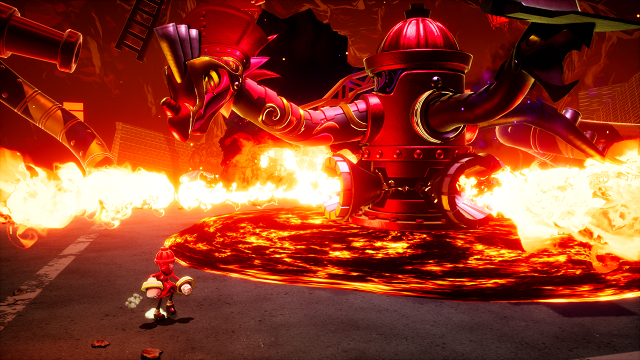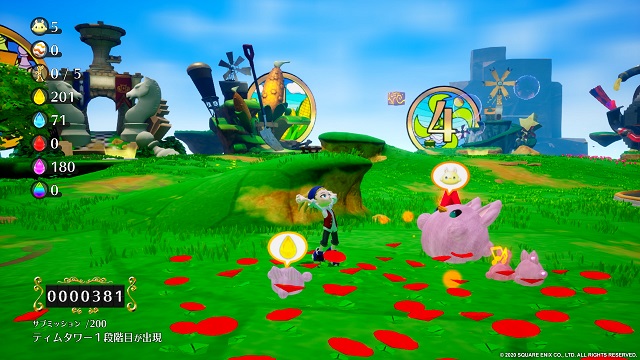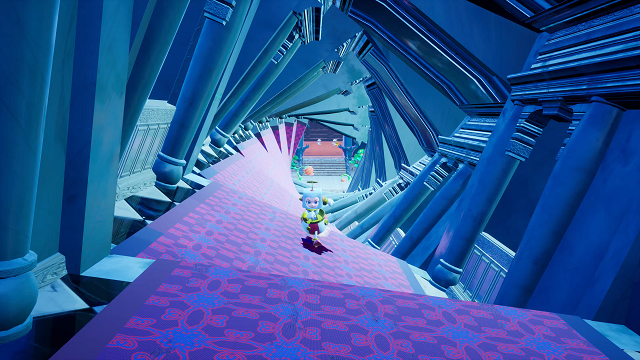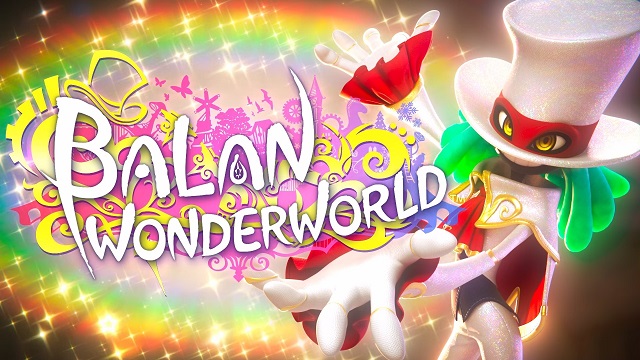Balan Wonderworld looks so promising. It’s bright and colorful, comes from a Square Enix subsidiary led by the creator of Nights Into Dreams and Sonic the Hedgehog, and gives off more than its fair share of classic, 3D platformer vibes. Even the opening cinematic, revealing the kinetic clown/maestro/god(?) Balan is full of wild energy and big, brassy music. It’s hard to imagine this game going poorly.
Then… it does.
The opening cinematic is, unfortunately, the high point here. Nothing is abjectly terrible in Balan Wonderworld, but almost nothing works. Its design and sensibilities feel hopelessly dated, the controls are oversimplified and lack tightness, and none of its elements live up to their potential.
Balan Wonderworld Review: Not Much Magic
Though the story is convoluted and difficult to make out since very little is explained either narratively or mechanically, the basic premise of Balan Wonderworld is this: you play as either Leo or Emma, or both if there are two players, who are each going through rough patches.
Depending on the character you choose, the game begins a bit differently. Emma begins by seeing people whispering behind her back everywhere she goes. Leo begins by dancing in the park, impressing people and then walking away without talking to anyone.
Regardless of which character you play as, they both end up in a dilapidated theater called Balan Wonderworld. Inside, they are greeted by Balan, an extremely well-dressed clown who performs a booming musical number and whisks them off to a magical world where they help other people who have lost their way.
Each “chapter” of Balan Wonderworld is themed around a different person, such as “The Man Who Rages at the Storm.” In each chapter, you collect costumes with different abilities and use them to then solve puzzles, and by doing so, collect different colored gems and Balan Statues. After collecting enough statues, new chapters open up in the hub.

The general idea is that each chapter has certain puzzles that require backtracking; you encounter objectives in early chapters that can only be solved after unlocking costumes in later chapters. It’s a creative way to add difficulty to Balan Wonderworld‘s simplified take on puzzles and platforming.
Everything else quickly comes off the rails.
Controls are important to every platformer’s success, but Balan‘s controls are often loose and unresponsive. You can move, perform actions while in a costume, and change your costume. If you aren’t in a costume, all you can do is jump, an action that gets mapped to all of the buttons.
If you change to your dragon costume, for example, that input switches to a fireball attack — but then you can’t jump. To jump again, you must switch to a different costume: one that has jump as its action. It’s extremely frustrating that such a basic action, one so pivotal to not just the game but the entire genre, isn’t useable at will.
Considering how much Balan Wonderworld hypes its massive selection of costumes, it shouldn’t be surprising that some of them are not exceptionally useful. Box Fox, for example, turns you into a fox and, periodically, into a box. If you’re on a slope when the costume decides to morph, you’ll very likely be starting the level over. It’s about as fun as it sounds.
I found myself always bringing along a costume that had a good attack move, one that had a good navigation move, and one that had some sort of specialty that helped solve puzzles.

Level design is imaginative, but everything looks horribly dated, making it difficult to gauge distances or even tell what’s a platform and what’s not. The lack of sharpness causes more than its fair share of frustration. There were multiple instances where I used a costume ability to “reach” a tough spot I thought was sure would have a Balan Statue, only to fall straight through the platform because it was not actually part of the level.
Each area also lacks clear urgency and goals. Balan Statues are strangely placed and don’t truly feel like objectives, removing any sense of accomplishment gained by nabbing them. Unlike Jiggies in Banjo-Kazooie or any objective in the Mario games, Balan Statues are just there. You grab them, just like you will the various colored gems scattered about. The latter of which brings us to yet another mysterious aspect of Balan Wonderworld: the Isle of Tims.
The Isle of Tims is a hub populated by Marshmallow Peep-looking critters called Tims that connects all of Balan Wonderworld‘s chapters. You can feed the gems you find in levels to these Tims, and they change colors and sometimes lay eggs. Other times, they jump on a wheel, which builds a giant tower in the middle of the hub space after a set number of rotations.
Different colored Tims have, supposedly, different abilities, though the jury is still out on that. The tower they build? It’s a thing the game tells me to do, but there’s no indication when it will be done or what it will do when it is. You just put your Tims to work, feeding them and watching them rotate a wheel until the tower reaches another tier. What a horrible life to be a Tim.
Balan Wonderworld Review — The Bottom Line

Pros
- Sense of wonder and magic in the cutscenes and worldbuilding
- Soundtrack is strong
- Lots of good ideas…
Cons
- …but equally poor execution
- Camera and controls leave a lot to be desired
- Animations and graphics are ugly and oversimplified
- Incredibly frustrating
Everything in Balan Wonderworld feels unfinished. If the gameplay could capture half the magic that the cutscenes exude, it would be a game worth a look.
Every chapter ends with an outrageous musical number, where the main character, the chapter subject, and a bunch of the costume characters sing, dance, and clap in a kaleidoscope of joy. Then you’re booted back to the Isle of Tims to watch your pet marshmallows build a clockwork idol.
That’s on top of the game’s weird sense of scale, where worlds roll into view nauseatingly, which literally made me dizzy more often than not.
With just a little (ok, a lot) more polish, Balan Wonderworld could be one of those delightfully weird games that develops a cult following. Instead, it seems to be a pretty significant misstep for Square Enix, who seemingly had high hopes that this would become a major hit.
It’s impossible to recommend Balan Wonderworld. It’s too simple for people who grew up on 3D platformers and likely too frustrating for newcomers. For every bold design choice or strong idea it presents, there are innumerable missteps. There is no real joy to be found in playing Balan Wonderworld.
Don’t be fooled into thinking this is like Kingdom Hearts, Banjo–Kazooie, Crash Bandicoot, or any other nostalgic, colorful action-platformer. Balan Wonderworld is a game that even patches and fixes won’t be able to mold into something you’ll want to play. Its flaws run far too deep.
[Note: Square Enix provided the copy of Balan Wonderworld used for this review.]







Published: Mar 30, 2021 4:40 PM UTC